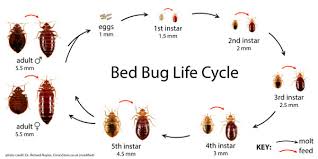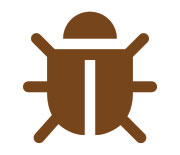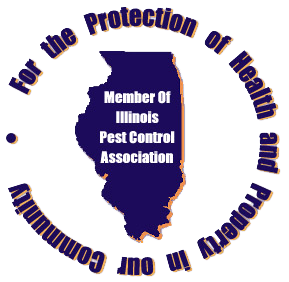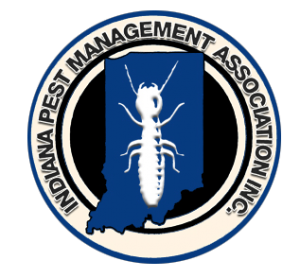“Sleep tight, don’t let the bedbugs bite.” A forgotten phrase that was once common place, now carries new meaning. Almost eliminated in the U.S. due to the widespread use of harsh chemical that are no longer EPA approved, Bedbugs have come back in force. Hopefully you will never have to share a bed with them, but should you encounter these troublesome pests, education is the first step towards prevention and if necessary, elimination.
Bedbugs are flat reddish-brown insects about the size of an apple seed that require a blood meal/host to survive. They undergo incomplete metamorphosis through instars meaning they hatch  from an egg as a nymph, small in size almost clear in color, before becoming an adult. After earning a blood meal (feeding) they become larger and form their reddish-brown color. Identification of bedbugs is necessary for several reasons. They can be confused for other insects such as fleas and ticks or even the condition known as delusional parasitosis. The use of a LED flashlight is critical during inspection to look for bedbug evidence or the bug itself. Key areas of activity are found in seams of mattresses and box springs, headboard/frame, couches and furniture, outlets and other areas where we spend a lot of time resting.
from an egg as a nymph, small in size almost clear in color, before becoming an adult. After earning a blood meal (feeding) they become larger and form their reddish-brown color. Identification of bedbugs is necessary for several reasons. They can be confused for other insects such as fleas and ticks or even the condition known as delusional parasitosis. The use of a LED flashlight is critical during inspection to look for bedbug evidence or the bug itself. Key areas of activity are found in seams of mattresses and box springs, headboard/frame, couches and furniture, outlets and other areas where we spend a lot of time resting.
Bedbugs are attracted to the warmth of our bodies and carbon dioxide we exhale. Usually emerging at night to feed, they can also forage during the day in areas where our bodies stay stagnant for long periods of time. Females can lay 3-5 eggs per day, but only after mating and ingesting a blood meal. Although it has been proven bedbugs can survive up to a year without feeding, most will not survive more than six months.
Dubbed the hitchhikers of the pest world, Bedbugs can be encountered and transported virtually anywhere. Overnight guests and used furniture are two of the most common ways in which bedbugs are introduced into a home. Hotel/condo stays, the use of public transportation and areas where we stay dormmate for extended periods of time (movie theaters) potentially expose us to bedbugs.
 Some tips when traveling or going to suspected hot spots are to inspect key areas, bring in minimal items at these places and do not place luggage on bed or furniture before inspection. Upon departure, do a self-check of yourself and belongings as a last effort safety net.
Some tips when traveling or going to suspected hot spots are to inspect key areas, bring in minimal items at these places and do not place luggage on bed or furniture before inspection. Upon departure, do a self-check of yourself and belongings as a last effort safety net.
There are a few treatment methods available to consumers to rid a home of bedbugs. With proper preparation from the homeowner coupled with the knowledge and efforts of a pest control professional, elimination can be achieved through chemical or non-chemical methods. What we recommend and have found to be the most efficient and cost-effective method of bedbug elimination is the application of pesticides to key areas of activity. Bedbugs then encounter this environmentally friendly insecticide and transport the active ingredient into their harborage and nesting sites. We do not recommend or perform non-chemical treatments using heat or cold due to higher price points, percentages of human error involved and lack of residual benefits.
In instances that require regular monitoring as a preventative or proactive measure we install traps and/or lures where bedbugs can be “caught” so that an infestation can be identified in the early stages and be more readily eliminated. These products are very beneficial in health facilities, assisted living, multi-unit housing or where there is constant human traffic.
Bedbug cases are increasing throughout the U.S. at an alarming rate. When homeowners and pest control professionals work together, bedbug elimination can be achieved through knowledge, proper identification and application. If you suspect bedbugs have moved into your home, call our office for a FREE ESTIMATE!








